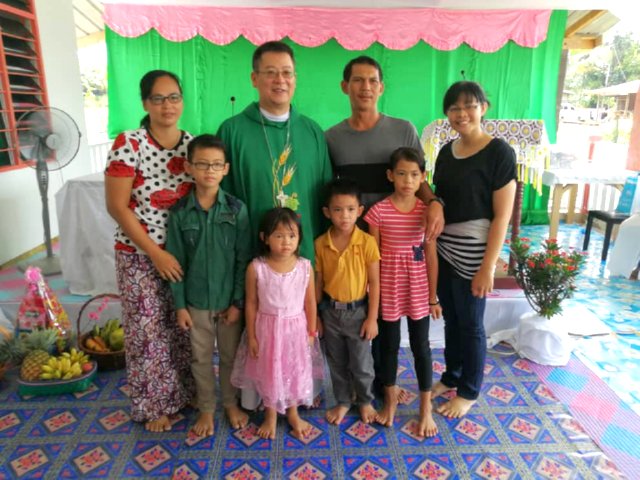Pastoral visit to Seping Tribe,
Long Bala, Belaga
Long Bala, Belaga
11th - 12August 2018
On 11th Aug to 12 August 2018, Rt Reverant Bishop Richard Ng made a very special Pastoral visit to the Seping long house in Long Bala, Belaga. This is a new longhouse built 5 or 6 years ago next to the original longhouse.
Mass at this longhouse was attended by about 200 men, women and children and was later followed by a grand feast. Many of the people are working in the towns and only come back for big celebrations and festivities.
Louis Lenjau represented the Uma Seping headman his father, Lenjau Lian who, although present for the bishop's visit, due to his age, was unable to fully participate in the festivities and merry making.
The Seping are among the few tiny ethnic minorities that have survived assimilation by bigger groups and exist today as a distinct community, keeping their cultural identity and language intact. Seping Long Bala is one of 4 branches of the Seping tribe, the earliest settlers of Belaga who were here even before the British came. The other settlements are Uma Seping Long Koyan, Uma Seping Kajang and Uma Seping Batu Enam. The group lived for many years along the Seping River, a tributary of the Belepeh, which, in turn, is a tributary of the Murum that flows into the Balui.
While big tribes like the Penans with their total population of 17,784 are catching the government’s and international attention, small vanishing tribes like the Sepings are facing a natural death with the assimilation of their culture and traditions into the bigger or stronger neighbouring tribes, especially the Kenyahs and the Kayans.
In the Uma Seping longhouse of Long Bala, the biggest settlement of the dwindling tribal community, there are only 26 families with a total population of 216. About 100 more Sepings are found at the other settlement of Long Koyan Lama. In all, there are roughly 500 Sepings left in the world today!
In 1956 they lived in one longhouse comprising 16 households at Long Koyan along the middle reaches of the Belaga River. Due to lack of employment here, many people migrated to the Tinjar in the mid 1960's. It was also while they were at Long Pejawai in the Tinjar, like most of the other indigenous people in the area they decided to accept Christianity and became Catholics in 1966 through Father De Varies, a Mill Hill Priest.
In the 80s, when timber companies started extracting timber and employing the local natives for work, the Seping tribe migrated back to their ancestral homeland Long Bala. It was also at that time many of the people in Long Bala became Catholics.
In 1974, Penghulu Kata Lawai was the only catholic in this longhouse. and was originally from Long Gang. By 1976, there were already 6 families and today, there are about 400 catholic families in this longhouse. 400 catholic families resettled here because of the Bakun dam about 20 years ago.
Although losing most of their culture, the Sepings still retain their language – a mixture of Kayan, Kenyah, Penan and Kejaman. Uma Seping Long Bala headman, Lenjau Lian, said there were once 22 Seping longhouses but that was a long time ago – and they now exist only in his memory.
He said as a small community, the Sepings were gradually losing their culture and traditions through assimilation into those of the Kenyahs and the Kayans.
“We don’t have our own music, dances, costumes, wedding ceremonies or death rituals anymore. The ceremonial practices for occasions like weddings and deaths usually belong to the other tribes, especially the Kayans and the Kenyahs.”
According to Lenjau, hitting the floor with a pole and rotating the pole is something the community still practise during a funeral wake “to make the death a happy one.”
However, he could not even recall the name of the practice, only describing as Kajang in nature but not Seping in originality.
There was the secondary burial practised long time ago by the Seping keta’ak (aristocracy) where the bones of the deceased were cleaned and stored in a jar which was then placed on top of a carved belian burial pillar known as salong.
The Sepings also used to practise the tradition of parap – epic recitation. However, it was only done in Kenyah tongue which even Lenjau finds it ironic. However, since accepting Roman Catholism in 1966, the community have abandoned the Bungan religion and no longer practise the adat burung (bird tradition) where all tasks are forbidden if an eagle or any other bird is making “a peculiar noise” and if a deer (kijang) is barking.
“We don’t celebrate Gawai like the rest of the Dayaks. We only celebrate Easter Day and Christmas,” Lenjau added.
Despite having a diluted culture, the Sepings still identify themselves as a distinct group, different from their other ethnic neighbours.
Photography - Jason Kho
Story by Johnny Tan
Compiled and edited by Ben Chang





























